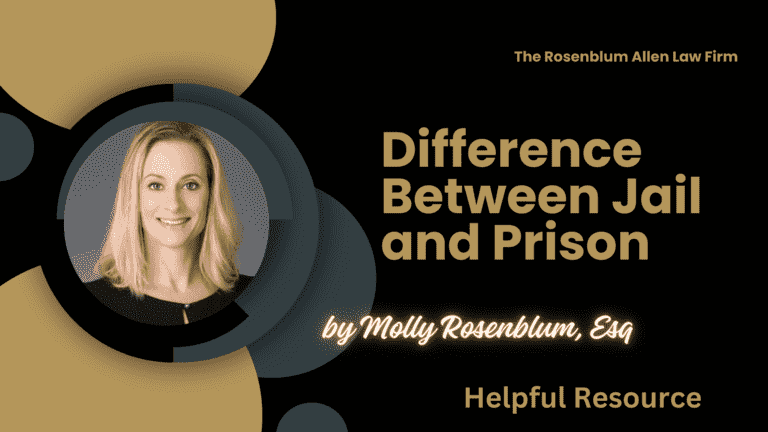Understanding the Difference Between Jail and Prison in Nevada
A Simple Guide to Know What Sets a Jail Apart From a Prison
Have you ever wondered what the difference is between a jail and a prison?
If so, you’re not alone. Even though they might seem similar, they’re actually quite different!
Let’s break it down and understand the difference between jail and prison in Nevada.

What is a Jail?
A jail is a place where people are held for a short time. Usually, people stay here while they’re waiting for their trial.
Sometimes, people might be in jail for a short period after they’ve been found guilty of a minor crime, like shoplifting or trespassing.
In Nevada, jails are typically run by local law enforcement agencies like the county sheriff’s office.
What is a Prison?
On the other hand, a prison is a place where people go if they’ve been found guilty of more serious crimes, like robbery or assault. Prison sentences are usually longer, which means people stay there for a longer time compared to jails.
In Nevada, prisons are run by the state government, which is different from jails because local agencies run those.
Key Differences
So, to sum up, the main differences between jail and prison in Nevada are:
- Length of Time: Jail is usually for a short-term stay, while prison is for long-term sentences.
- Type of Crime: Jail is for less severe crimes or while waiting for trial. Prison is for more severe crimes.
- Who Runs It: Jails are managed by local law enforcement, while the state government manages prisons.
Understanding the difference between jail and prison can help you better understand how our legal system works.
And remember, if you or a loved one ever need legal help, a defense attorney can guide you through the process and protect your rights.
Diving Deeper into Nevada's Jails and Prisons
A Closer Look at the Functions, Facilities, and Legal Aspects
After understanding the fundamental differences between a jail and a prison, let’s dig deeper into how these two types of facilities operate in Nevada.
More About Jails
Like in many other places, jails in Nevada are typically used for those awaiting trial or serving short sentences.
But did you know they also provide additional services?
Some people in jail may be taking part in work release programs, getting educational training, or receiving substance abuse treatment.
These programs aim to help individuals improve their lives and reduce the chances of getting into trouble with the law again.
More About Prisons
Prisons, on the other hand, are designed for long-term confinement.
Nevada has several state prisons, each of which houses inmates serving extended sentences.
Prisons often have different security levels—from minimum to maximum—based on the severity of the crimes committed by the inmates and their potential risk to others.
In prison, inmates usually have access to various programs like vocational training, college courses, and rehabilitation programs.
These programs aim to help individuals develop skills and behaviors that can help them reintegrate into society when they are released.
Legal Help Matters
If you or a loved one is facing legal trouble, it’s essential to understand the seriousness of the situation. Being sent to jail or prison can have long-lasting impacts on a person’s life.
That’s why it’s crucial to have a defense attorney who can help navigate the legal process, protect your rights, and reduce the severity of the consequences.
Why You Have Not Hired a Felony Defense Attorney Yet
Watch this short video to take the next big step toward defending your rights against a felony charge.

Breaking It All Down for You
Understanding the difference between jail and prison is crucial in grasping how the legal system functions in Nevada. Jails, managed by local law enforcement, hold individuals awaiting trial or serving short sentences for less serious offenses. They also offer programs like work release, educational training, and substance abuse treatment.
Prisons, managed by the state government, house individuals serving long-term sentences for more serious crimes. They have varying security levels and provide vocational training, college courses, and rehabilitation programs.

Frequently Asked Questions
What kind of crimes usually result in short-term jail sentences?
Short-term jail sentences typically stem from misdemeanors, such as petty theft, simple assault, disorderly conduct, trespassing, or first-time DUI offenses.
How long does a person stay in jail while awaiting trial?
The duration of jail stay during the trial’s anticipation varies. Factors like the charges’ nature, court scheduling, and bail status influence the length. It can range from a few hours or days to several months or even years in some instances.
What types of rehabilitation programs are offered in Nevada prisons?
Nevada prisons offer diverse rehabilitation programs, including substance abuse treatment, mental health counseling, vocational training (e.g., carpentry, plumbing), and educational opportunities leading to GEDs or college degrees.
What is a work release program in a jail?
A work release program enables jail inmates to work at civilian jobs while serving their sentences. During work hours, they leave the jail, returning after their shifts. This initiative helps them earn money, gain work experience, and gradually reintegrate into society.
What is the process if a person is moved from jail to prison?
If convicted of a serious crime with a long-term sentence, individuals may transition from jail to prison. Typically, they’re transferred to a state prison post-sentencing. They may first undergo evaluation at a reception center, determining their assigned prison facility.
Are there different types of prisons in Nevada?
Yes, Nevada has various prison types classified by security level: minimum, medium, and maximum security. The allocation depends on factors like the offense, sentence duration, behavior, and potential risk to others.

Additional Resources for You
For our readers seeking comprehensive legal guidance, it’s essential to highlight that our lead attorney, Molly Rosenblum Allen, Esq., is not only an expert in her field but has also created a wealth of resources to assist you during challenging times. Below are invaluable resources crafted by Molly, each addressing critical legal topics and questions:
Double Jeopardy: A deep dive into the complexities of double jeopardy, explaining how it can impact legal proceedings.
Hung Jury: An insightful exploration of what a hung jury means and the potential implications in the judicial system.
Circumstantial Evidence: A detailed analysis of the role and significance of circumstantial evidence in criminal cases.
Indicted vs Charged: A clear, concise breakdown of the differences between being indicted and charged, and what each term entails legally.
What are Miranda Rights: An essential guide to understanding Miranda Rights and their crucial role in the legal process.
How to Check if You Have an Outstanding Warrant: Step-by-step instructions on how to verify if there’s an outstanding warrant against you, a vital resource for proactive legal awareness.
What to Look for in a Criminal Defense Lawyer: Expert advice on selecting the right criminal defense lawyer, highlighting key qualities and considerations.
Possible Ways to Reduce a Felony Charge: Strategic insights into reducing a felony charge, offering hope and guidance for those facing serious accusations.
Should You Accept a Plea Bargain: A crucial examination of plea bargains, empowering readers with knowledge to make informed decisions in their legal strategy.
We encourage our readers to explore these resources thoroughly to gain a clearer understanding of their legal situations and to make well-informed decisions. Molly Rosenblum Allen, Esq.’s expertise and dedication to educating and assisting the public are evident in each of these comprehensive guides.

Offsite Resources You May Find Helpful
Here are seven offsite resources that might be useful to readers interested in understanding more about the criminal justice system:
American Civil Liberties Union: The ACLU strives to uphold everyone’s civil liberties, no matter who they are or what their situation might be. They work in courts, legislatures, and communities to protect and extend basic rights for everyone in America.
National Association of Criminal Defense Lawyers: This national organization provides resources and advocacy for criminal defense lawyers, and information and assistance to the public.
Federal Bureau of Prisons: This government agency oversees the incarceration of federal prisoners. Their website provides a wealth of information about federal prisons.
The Sentencing Project: This organization works for a fair and effective U.S. criminal justice system by promoting reforms in sentencing policy, addressing unjust racial disparities and practices, and advocating for alternatives to incarceration.
The Innocence Project: This organization works to exonerate the wrongly convicted through DNA testing and reforms in the criminal justice system.
Center on Wrongful Convictions: Part of Northwestern University, this organization is dedicated to identifying and rectifying wrongful convictions and other serious miscarriages of justice.
National Legal Aid & Defender Association: This organization is committed to ensuring equal access to justice for all Americans, providing resources for those in need of legal defense.

A Special Message From Our Lead Attorney

Molly Rosenblum, Esq
Dear Reader,
Thank you so much for reading our resources on the differences between jail and prison. I understand that navigating the legal system can be complex and often stressful. My team and I are committed to providing reliable, easy-to-understand information.
If you or a loved one faces legal challenges, remember that you don’t have to face them alone. We offer a free consultation to understand your situation and discuss how we can assist you.
Please call us at (702) 433-2889 to schedule your free consultation. Our team is here to help you make sense of the legal complexities and provide guidance in your time of need.
Thank you again for your time, and I look forward to the opportunity to assist you.
Best,
Molly Rosenblum, Esq.



